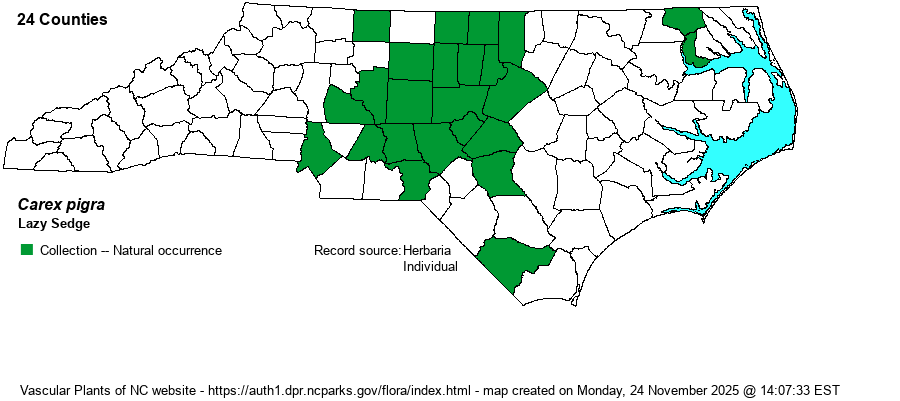| Author | Naczi | |
| Distribution | Almost confined to the middle and lower Piedmont; rare on the Coastal Plain. Extends down the Cape Fear River to Columbus County.
Southeastern VA to central TN, south to northern FL, southern AL, and northeastern MS. | |
| Abundance | Frequent in the Piedmont; very rare in the Coastal Plain, except rare along parts of the Cape Fear River. The website editors assign a State Rank of S3S4, as it appears that the NCNHP has no rank assigned for it. | |
| Habitat | Floodplain forests and bottomlands along brownwater rivers and streams. Near blackwater streams in Gates and Chowan counties. |
| Phenology | Flowering and fruiting May-June. | |
| Identification | Until 1997, C. flaccosperma included plants now named C. pigra, which can occur in the same moist habitats. Both have strongly glaucescent or glaucous leaves and stems, but C. flaccosperma has larger perigynia (4.2-5.5 mm long vs. 3.9-4.5 mm long). Another close relative is C. glaucodea of dry uplands, which has perigynia 3.2-4 mm long. | |
| Taxonomic Comments | Described in 1997, a split from C. flaccosperma.
The genus Carex is the largest in North America, and among the largest in the world. In temperate and boreal regions, Carex is often the dominant or co-dominant ground layer in many habitats. Seeds (achenes) are valuable food for birds and small mammals, while foliage is used by birds and mammals to make nests and as food by mammals. Species of Carex often look vastly different from one another -- spikes erect vs. drooping, tiny inflorescence vs. whopping, culms leafy vs. naked, perigynia beaked vs. beakless, stems densely bunched vs. single, etc. The genus has been divided into many sections (or groups), based on shared characters; some taxonomists have suggested that these be different genera, but that proves unworkable (so far). All Carex share the feature of a perigynium (an outer covering) which completely surrounds the achene (seed). This covering may fit tightly or loosely (like a small bladder), depending on which group or species. Details of perigynia shape, ornamentation, presence and size of beak, number of striations (or veins) are all important ID features. In recent years Rob Naczi and colleagues have stressed the importance of arrangement of perigynia -- whether spiral (3+ ranks) or distichous (2-ranked) -- and have named a number of new species as well as split off some older synonyms. Therefore, RAB's (1968) key, excellent for its time, can only be used in a general way today. Members of some sections of Carex are difficult to key out (notably Ovales, Laxiflorae, Griseae); this is in part due to variation among individuals of a species, or failings of the key. FNA has drawings of most species and some species may be found in two or more places within a key, to acount for variability. New species to NC, and new to science(!), continue to be found in NC. | |
| Other Common Name(s) | Tarheel Sedge -- the common name in use for C. austrocaroliniana. | |
| State Rank | [S3S4] | |
| Global Rank | GNR | |
| State Status | | |
| US Status | | |
| USACE-agcp | FACW link |
| USACE-emp | FACW link |

